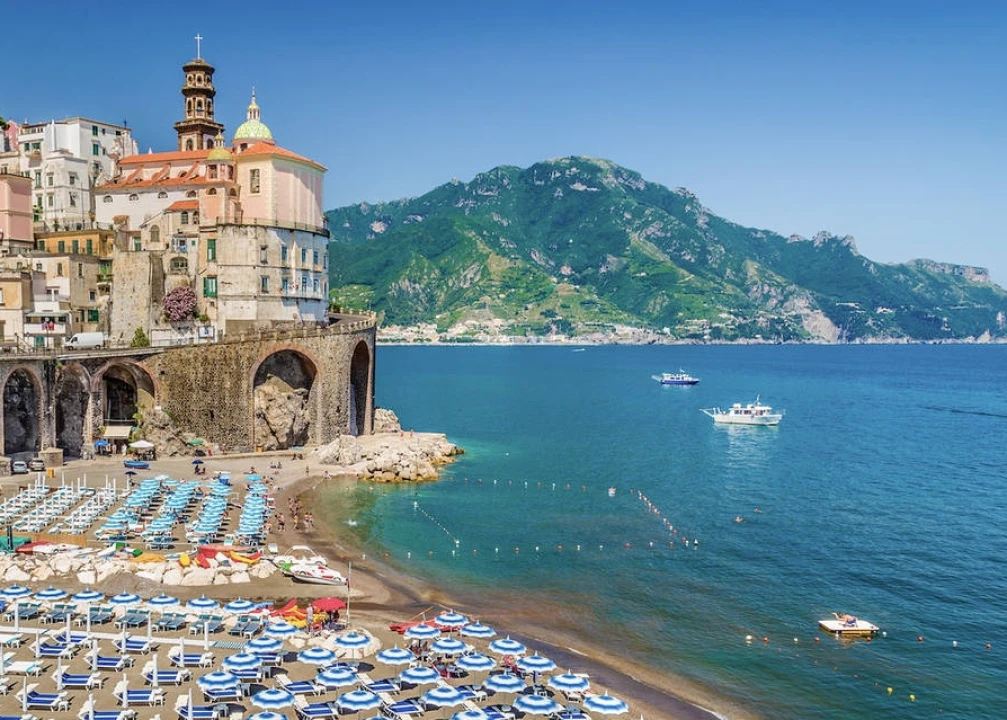Facing the Tyrhennian Sea, the Amalfi Coast is one of 50 Italian sites inserted on the UNESCO World Heritage List. The Amalfi Coast seems to be one grand balcony suspended between a sea of cobalt blue and the feet of the Lattari Mountains, in a long stretch of hollows and promontories, coves, cultivated terraces, vineyards, and citrus and olive groves.
Set in a unique environment, it is an exemplar of a Mediterranean landscape and of enormous cultural and natural value due to its topographical characteristics, as well as its historical evolution. For this, it is protected by UNESCO.
The entire area extends over 11,231 hectares between the Gulf of Naples and the Gulf of Salerno, comprising 16 splendid communes inside the Province of Salerno: Amalfi, Atrani, Cava de' Tirreni, Cetara, Conca dei Marini, Furore, Maiori, Minori, Positano, Praiano, Raito, Ravello, Sant'Egidio del Monte Albino, Scala, Tramonti, and Vietri sul Mare.
The cities and countryside towns of the Amalfi Coast are different one from the other, each with its own traditions and peculiarities that render them singular and unique; nonetheless, they are all characterized by architectonic monuments like the Saracen Tower of Cetara; the Romanesque Cathedral of Amalfi and its “Cloister of Paradise,” clearly under the Oriental influence; the Church of San Salvatore de’ Bireto in Atrani, where the swearing-in ceremony for the Doges of Amalfi traditionally takes place; and Ravello, with its beautiful cathedral and the superb Villa Rufolo.
The enchanting town of Vietri sul Mare is considered to be the “cradle of majolica;” thus it is no random fact that the gorgeous Church of San Giovanni Battista and the facade of the Arciconfraternita dell’Annunziata e del Rosario are covered in these splendid and colorful ceramic tiles.
On the road from Amalfi that arrives in the “painted village” of Furore, one will find the charming borgo of Conca Dei Marini, characterized by its homes with white vaulted roofs from the 16th Century, and by its emerald grotto.
Additionally, the fishing villages of Cetara and Maiori – also among the most-frequented sea resorts due to their fine, sandy beaches – boast, respectively, the Churches of San Pietro and Santa Maria a Mare, both domes of which are covered in majolica.
Another gem along the Coast is Minori, defined as a Coastal Eden for its fresh and airy climate.
Meanwhile, in the Valley of the Dragon rises the very pretty Atrani – far away from the touristic masses, this tiny city still holds on to its marine authenticity. (If you go, be sure to see the stupendous piazzetta on the sea.)
Then, one of the best-known spots is Amalfi, the namesake for the coast that was founded in the 4th Century B.C.
An ancient marine republic, Amalfi long held the monopoly for commerce in the Tyrhennian, exporting Italian goods (wood, iron, arms, fruit and wine) to eastern markets in exchange for spices, perfume, pearls, jewels, textiles and rugs, to then trade in the west.
The disposition of the habitations here is highly influenced by the East, in some ways recalling a souk with its homes gathered together in clinging groups, connected only by small, labyrinth-like alleyways and staircases.
It is in Amalfi that the characteristic, Sicilian-Arabesque architecture was born and developed – of which the Duomo of Sant’Andrea Apostolo is a perfect example. Rebuilt in Baroque forms in the 1700s, the Duomo features a marvelous stairway and cloister, the aforementioned Chiostro del Paradiso. The Duomo or Cathedral is one of the most-visited monuments on the Coast.
Passing through lovely Praiano, one arrives at Positano, a resort spot even since Roman times, with its striking white houses that seem to sweep down toward the sea as they also group around the Church of Santa Maria Assunta (again, the dome is done in majolica).
Typical are its numerous, narrow walkways abundant in bottegas (artisan workshops), where visitors can acquire local products, and the countless scalinate or staircases that run high to low, always ending at the beach.
Its principal beaches include the Spiaggia Grande and Fornillo Beach, each connected to pedestrian paths for easy accessibility; then, La Porta, Arienzo and San Pietro Laurito, which are not easy to get to unless you arrive via the sea.
Then come the Coast’s higher-up villages: Scala, Tramonti, Raito – known for its typical stairways, also the only means to move around the town – and Ravello. At 350 meters (1,148 feet) in altitude, Ravello is one of the Coastal gems, with its villas, gardens and panamoric views that denote absolute charm and elegance – first among them the breathtaking Villas Rufolo and Cimbroneri.
Finally, at the bases of the Lattari Mountains stands Sant'Egidio del Monte Albino, famous for the Abbey of Santa Maria Maddalena in Armillis and for its cute historic center.




